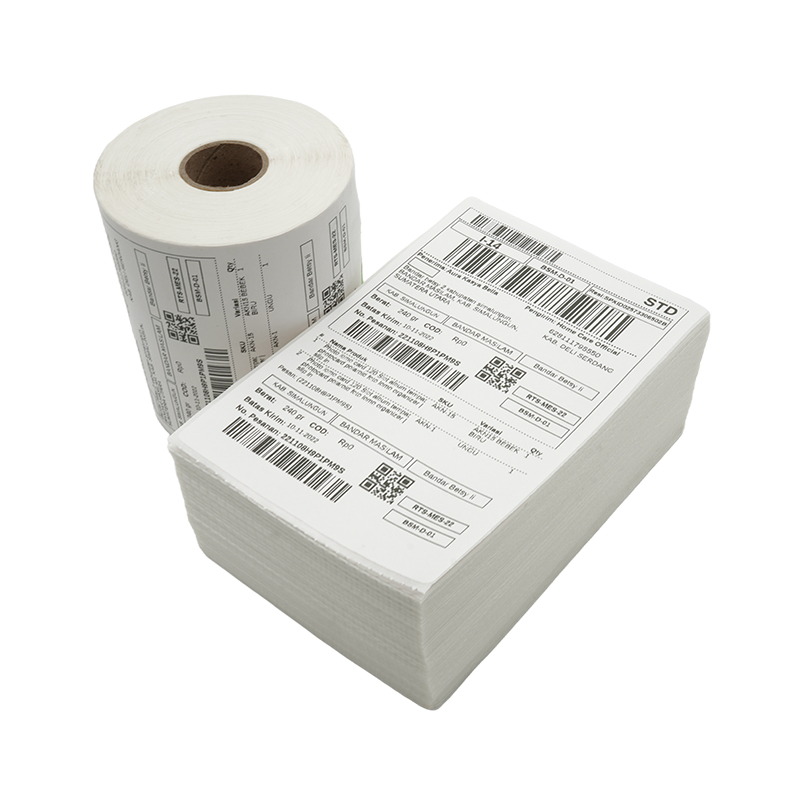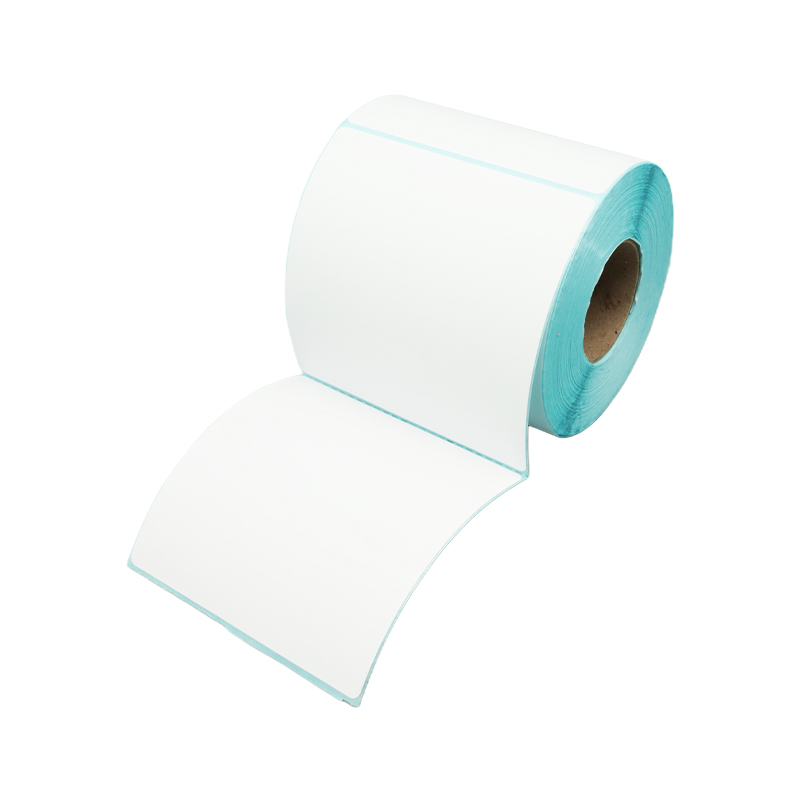How does blue grid thermal tag paper facilitate rapid identification in warehousing and logistics?
Release Time : 2025-09-03
In modern warehousing and logistics systems, information accuracy, readability, and processing efficiency are directly linked to the operational effectiveness of the entire supply chain. From incoming goods registration, shelf positioning, picking and sorting, to outbound verification, every process relies on clear and standardized label information. Among numerous label printing solutions, blue grid thermal tag paper, with its unique visual design and efficient printing capabilities, is gradually becoming an "invisible assistant" in warehouse management, playing a vital role in improving information recognition speed, reducing operational errors, and optimizing operational processes.
1. Grid Design: Structured Layout for Efficient Information Organization
The most distinctive feature of blue grid thermal tag paper is the fine blue grid lines printed on its background. This grid is not decorative, but a visual guidance system. During printing, the warehouse management system precisely aligns information such as product name, barcode, batch number, location number, weight, and expiration date onto the grid lines, creating a uniform layout. For human readers, the grid lines act like an invisible grid, separating cluttered information into clear blocks and preventing overlapping, misaligned, or crowded text. This allows pickers to quickly locate key fields when scanning or verifying, reducing visual search time. For example, the barcode is always located in the upper right corner of the grid area, and the production date is fixed in the lower left corner. This consistency significantly improves recognition efficiency, especially in high-intensity, fast-paced sorting operations, where every second saved means overall efficiency gains.
2. Blue Background: A Balance between High Contrast and Low Visual Fatigue
Unlike traditional black-on-white labels, blue grid labels use a light blue or sky blue background, while thermally printed text appears deep black. This color scheme achieves the dual advantages of high contrast and visual comfort. The black carbon text stands out clearly against the blue background, ensuring excellent readability even in dimly lit warehouse corners or in brightly lit shipping areas. Furthermore, blue, a cool color, has a soothing and calming visual effect. Compared to the strong reflections from a pure white background, the blue grid effectively reduces visual fatigue caused by prolonged staring at labels, making it particularly suitable for warehouse staff who work continuously for hours. This "clear and long-lasting" feature helps maintain focus and reduces the risk of mispicking or missing items due to fatigue.
3. Assisting Handwriting and Temporary Marking, Enhancing Flexibility
Although automated printing is the mainstream, in practice, there are still situations where handwritten supplemental information is required, such as last-minute changes, replenishment markings, and exception notes. The blue grid provides a natural "coordinate reference" for handwriting. When filling in blank spaces on labels with a regular ballpoint pen or marker, warehouse staff can use the grid lines to maintain neat handwriting and avoid the messy effects of graffiti. For example, when processing returns, designated grid areas can be quickly marked with "pending quality inspection" or "batch exception" to ensure clear and accurate information. The grid lines also serve as a simple dimensional reference. When temporarily measuring small items or marking packaging dimensions, warehouse staff can use the grid spacing as a ruler for rough comparison, improving on-site processing efficiency.
4. Anti-counterfeiting and anti-mixup design enhances management security
In warehouse environments with multiple product categories and batches, label mix-up is a common risk. The blue grid serves as a visually differentiated identifier, helping warehouses quickly distinguish between different types of materials. For example, blue grid labels can be used for high-value goods, cold chain products, or batches requiring critical monitoring, while white labels are used for general consumables. This color-coding strategy allows employees to initially identify the goods from a distance, reducing the chance of misplacing the wrong items. Furthermore, the combination of blue dye and thermal coating makes counterfeiting more difficult. Lower-quality label paper struggles to replicate the same grid precision and color stability, so the blue grid label itself offers a degree of anti-counterfeiting protection, ensuring the authenticity of logistics information.
5. Compatible with thermal printing technology for efficient, ink-free operation
Blue grid thermal paper utilizes thermal coating technology, enabling direct color development in thermal printers without the need for ribbons or ink. This feature results in a quieter and cleaner printing process, preventing issues such as ribbon breakage and ink clogging, making it ideal for automated warehousing systems operating 24/7. Available in pre-cut or continuous roll packaging, it enables high-speed batch printing, meeting the timeliness requirements of large orders.
Blue Grid Thermal Tag Paper is not only a carrier of information but also an "intelligent auxiliary tool" in warehousing and logistics. Through its structured grid layout, scientific color matching, and efficient printing technology, it achieves multiple breakthroughs in the core requirement of "quick identification." From improving typographical standardization to reducing visual fatigue, from supporting handwritten annotations to enhancing anti-aliasing capabilities, the Blue Grid Label, with its subtle yet practical design, quietly improves warehouse operational accuracy and efficiency.
1. Grid Design: Structured Layout for Efficient Information Organization
The most distinctive feature of blue grid thermal tag paper is the fine blue grid lines printed on its background. This grid is not decorative, but a visual guidance system. During printing, the warehouse management system precisely aligns information such as product name, barcode, batch number, location number, weight, and expiration date onto the grid lines, creating a uniform layout. For human readers, the grid lines act like an invisible grid, separating cluttered information into clear blocks and preventing overlapping, misaligned, or crowded text. This allows pickers to quickly locate key fields when scanning or verifying, reducing visual search time. For example, the barcode is always located in the upper right corner of the grid area, and the production date is fixed in the lower left corner. This consistency significantly improves recognition efficiency, especially in high-intensity, fast-paced sorting operations, where every second saved means overall efficiency gains.
2. Blue Background: A Balance between High Contrast and Low Visual Fatigue
Unlike traditional black-on-white labels, blue grid labels use a light blue or sky blue background, while thermally printed text appears deep black. This color scheme achieves the dual advantages of high contrast and visual comfort. The black carbon text stands out clearly against the blue background, ensuring excellent readability even in dimly lit warehouse corners or in brightly lit shipping areas. Furthermore, blue, a cool color, has a soothing and calming visual effect. Compared to the strong reflections from a pure white background, the blue grid effectively reduces visual fatigue caused by prolonged staring at labels, making it particularly suitable for warehouse staff who work continuously for hours. This "clear and long-lasting" feature helps maintain focus and reduces the risk of mispicking or missing items due to fatigue.
3. Assisting Handwriting and Temporary Marking, Enhancing Flexibility
Although automated printing is the mainstream, in practice, there are still situations where handwritten supplemental information is required, such as last-minute changes, replenishment markings, and exception notes. The blue grid provides a natural "coordinate reference" for handwriting. When filling in blank spaces on labels with a regular ballpoint pen or marker, warehouse staff can use the grid lines to maintain neat handwriting and avoid the messy effects of graffiti. For example, when processing returns, designated grid areas can be quickly marked with "pending quality inspection" or "batch exception" to ensure clear and accurate information. The grid lines also serve as a simple dimensional reference. When temporarily measuring small items or marking packaging dimensions, warehouse staff can use the grid spacing as a ruler for rough comparison, improving on-site processing efficiency.
4. Anti-counterfeiting and anti-mixup design enhances management security
In warehouse environments with multiple product categories and batches, label mix-up is a common risk. The blue grid serves as a visually differentiated identifier, helping warehouses quickly distinguish between different types of materials. For example, blue grid labels can be used for high-value goods, cold chain products, or batches requiring critical monitoring, while white labels are used for general consumables. This color-coding strategy allows employees to initially identify the goods from a distance, reducing the chance of misplacing the wrong items. Furthermore, the combination of blue dye and thermal coating makes counterfeiting more difficult. Lower-quality label paper struggles to replicate the same grid precision and color stability, so the blue grid label itself offers a degree of anti-counterfeiting protection, ensuring the authenticity of logistics information.
5. Compatible with thermal printing technology for efficient, ink-free operation
Blue grid thermal paper utilizes thermal coating technology, enabling direct color development in thermal printers without the need for ribbons or ink. This feature results in a quieter and cleaner printing process, preventing issues such as ribbon breakage and ink clogging, making it ideal for automated warehousing systems operating 24/7. Available in pre-cut or continuous roll packaging, it enables high-speed batch printing, meeting the timeliness requirements of large orders.
Blue Grid Thermal Tag Paper is not only a carrier of information but also an "intelligent auxiliary tool" in warehousing and logistics. Through its structured grid layout, scientific color matching, and efficient printing technology, it achieves multiple breakthroughs in the core requirement of "quick identification." From improving typographical standardization to reducing visual fatigue, from supporting handwritten annotations to enhancing anti-aliasing capabilities, the Blue Grid Label, with its subtle yet practical design, quietly improves warehouse operational accuracy and efficiency.







